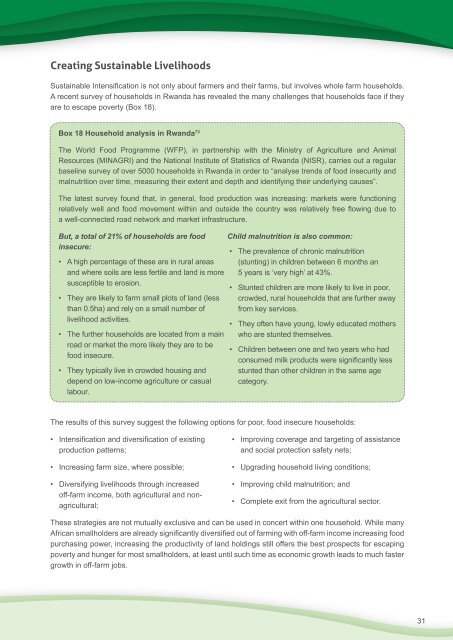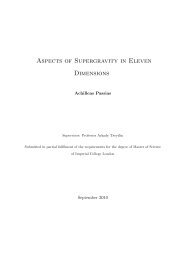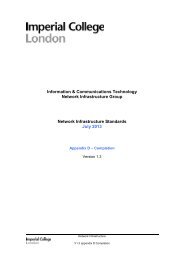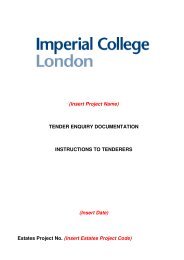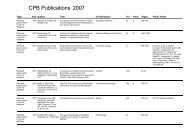Sustainable Intensification: - Workspace - Imperial College London
Sustainable Intensification: - Workspace - Imperial College London
Sustainable Intensification: - Workspace - Imperial College London
You also want an ePaper? Increase the reach of your titles
YUMPU automatically turns print PDFs into web optimized ePapers that Google loves.
Creating <strong>Sustainable</strong> Livelihoods<br />
<strong>Sustainable</strong> <strong>Intensification</strong> is not only about farmers and their farms, but involves whole farm households.<br />
A recent survey of households in Rwanda has revealed the many challenges that households face if they<br />
are to escape poverty (Box 18).<br />
Box 18 Household analysis in Rwanda 73<br />
The World Food Programme (WFP), in partnership with the Ministry of Agriculture and Animal<br />
Resources (MINAGRI) and the National Institute of Statistics of Rwanda (NISR), carries out a regular<br />
baseline survey of over 5000 households in Rwanda in order to “analyse trends of food insecurity and<br />
malnutrition over time, measuring their extent and depth and identifying their underlying causes”.<br />
The latest survey found that, in general, food production was increasing: markets were functioning<br />
relatively well and food movement within and outside the country was relatively free flowing due to<br />
a well-connected road network and market infrastructure.<br />
But, a total of 21% of households are food<br />
insecure:<br />
• A high percentage of these are in rural areas<br />
and where soils are less fertile and land is more<br />
susceptible to erosion.<br />
• They are likely to farm small plots of land (less<br />
than 0.5ha) and rely on a small number of<br />
livelihood activities.<br />
• The further households are located from a main<br />
road or market the more likely they are to be<br />
food insecure.<br />
• They typically live in crowded housing and<br />
depend on low-income agriculture or casual<br />
labour.<br />
The results of this survey suggest the following options for poor, food insecure households:<br />
• <strong>Intensification</strong> and diversification of existing<br />
production patterns;<br />
• Increasing farm size, where possible;<br />
• Diversifying livelihoods through increased<br />
off-farm income, both agricultural and nonagricultural;<br />
Child malnutrition is also common:<br />
• The prevalence of chronic malnutrition<br />
(stunting) in children between 6 months an<br />
5 years is ‘very high’ at 43%.<br />
• Stunted children are more likely to live in poor,<br />
crowded, rural households that are further away<br />
from key services.<br />
• They often have young, lowly educated mothers<br />
who are stunted themselves.<br />
• Children between one and two years who had<br />
consumed milk products were significantly less<br />
stunted than other children in the same age<br />
category.<br />
• Improving coverage and targeting of assistance<br />
and social protection safety nets;<br />
• Upgrading household living conditions;<br />
• Improving child malnutrition; and<br />
• Complete exit from the agricultural sector.<br />
These strategies are not mutually exclusive and can be used in concert within one household. While many<br />
African smallholders are already significantly diversified out of farming with off-farm income increasing food<br />
purchasing power, increasing the productivity of land holdings still offers the best prospects for escaping<br />
poverty and hunger for most smallholders, at least until such time as economic growth leads to much faster<br />
growth in off-farm jobs.<br />
31


